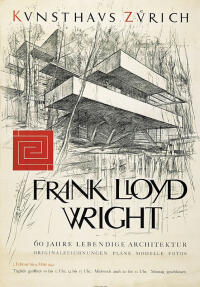Frank Lloyd Wright
02.02.1952 – 16.03.1952
Location Kunsthaus.
Location Kunsthaus.
Frank Lloyd Wright's Triumphal Procession Makes a Stop in Zurich
Even architecture could be a theme at the Kunsthaus. In 1952, Frank Lloyd Wright (*1867 Richland Center, Wisconsin; † 1959 Phoenix, Arizona) was honored with a traveling exhibition on his life's work. On display were sixteen models with a view through their removable roofs, plans, and large-format photographs of his most important buildings. Originally developed in 1951 by architect Oscar Storonov for the Gimbel Brothers Department Store in Philadelphia, the show had its first European stop at Palazzo Strozzi in Florence and then traveled on to Zurich, Paris, Munich, and Rotterdam, and two years later to Mexico, New York, and Los Angeles.
The exhibition and publication were titled 60 Years of Living Architecture. In the preface, Wright, who had traveled to Switzerland twice, wrote: ‘A free architecture for free people is only free so long as maintained on a basis of principle.’ Wright is regarded as an architect who strove for harmony between man and nature and saw himself as part of an organic architecture. Emblematic of this are the Solomon R. Guggenheim Museum in New York, which opened in 1959, and the Villa Fallingwater, built for the industrialist Edgar J. Kaufmann on a small waterfall, which was chosen as the subject of the exhibition poster.
In just nine weeks, a remarkable 22,000 visitors attended the Zurich exhibition, during which 1300 catalogs were sold. The show was brought to Zurich by Werner Max Moser, son of the Kunsthaus builder Karl Moser and architect of the Kongresshaus. Moser, who also gave the opening address, had worked for Wright in the USA for two years in the 1920s. As he put it in the catalog, ‘This exhibition is likely to have an encouraging and stirring effect and to spur us on to recognize the positive and creative beginnings of our civilization and develop them with courage and imagination, despite all the uncertainty and negativity of the present time.’
In the press, the exhibition was widely noticed nationally and internationally and was celebrated everywhere. The Neue Zürcher Zeitung, for example, admired the clarity of Wright's buildings, the courage in their bold execution, and their synthetic power: ‘The artistic sensibility associated with all this, and the ability to produce beauty, this is the gift of the gods that has been bestowed upon him.’
[Peter Stohler]
‘This exhibition is likely to have an encouraging and stirring effect and to spur us on to recognize the positive and creative beginnings of our civilization and develop them with courage and imagination, despite all the uncertainty and negativity of the present time.’Werner Max Moser, 1952

exhibition poster
Design: Walter Roshardt
Design: Walter Roshardt